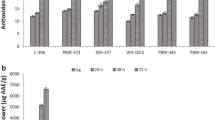Abstract
The antioxidant activity of the grain of the 18 varieties of winter rye was evaluated. The total content of antioxidants (TCA) varied depending on both the variety genotype and the year’s weather conditions. Three groups of the varieties, which essentially differed in TCA level, were segregated. A negative correlation between TCA and the weight of 1000 grains (r = −0.59 ± 0.16) was found. In the recovery of boltings, contrasting varieties differed a little (by 3.5%); however, the content of antioxidants in the boltings was twice the content of that in flour. The main antioxidant was ferulic acid, whose content varied from 69.0 to 92.0 mg/100 g of dry matter depending on variety. In small-grained rye varieties, the content of ferulic acid was higher than that in large-grained. It was concluded that the TSA indicator can serve as effective criterion when a rye is selected for the high content of antioxidants.
Similar content being viewed by others
References
Zelinski, H. and Kozlowska, H., Antioxidant activity and total phenolics in selected cereal grains and their different morphological fractions, J. Agric. Food Chem., 2000, vol. 48, no. 6, pp. 2008–2016.
Janda, T., Szalai, G., Rios-Gonzalez, K., Veisz, O., and Paldi, E., Correlation between frost tolerance and antioxidant activities in cereals, Acta Biol. Szegediensis, 2002, vol. 46, nos. 3–4, pp. 67–69.
Yashin, A.Ya., Yashin, Ya.I., and Chernousova, N.I., Natural antioxidants as the reliable protection of a man from diseases and senescence, Kurort. Vedom., 2008, vol. 49, no. 4, pp. 44–45.
Slavin, J., Jacobs, D., and Marquart, L., Whole-grain consumption and chronic disease: Protective mechanisms, Nutr. Cancer, 1997, vol. 27, pp. 14–21.
Kroon, P.A. and Williamson, G., Hydroxycinnamates in plants and food: current and future perspectives, review, J. Sci. Food Agric., 1999, vol. 79, pp. 355–361.
Graf, E., Antioxidant potential of ferulic acid, Free Rad. Biol. Med., 1992, vol. 13, pp. 435–448.
Garsia-Conesa, M.T., Plumb, G.W., Kroon, P.A., Wallace, G., and Williamson, G., Antioxidant properties of ferulic acid dimmers, Redox Rep., 1997, vol. 3, pp. 239–244.
Andreasen, M.F., Christensen, L.P., Meyer, A.S., and Hansen, A., Release of hydroxycinnamic and hydroxybenzoic acids in rye by commercial plant cell wall degrading enzyme preparations, J. Agric. Food Chem., 1999, vol. 79, pp. 411–413.
Rybka, K., Sitarski, J., and Rachynska-Bojanowska, K., Ferulic acid in rye and wheat grain and grain dietary fibre, Cereal Chem., 1993, vol. 70, no. 1, pp. 55–59.
Lempereur, I., Rouau, X., and Abecassis, J., Arabinoxylan and ferulic acid variation in durum wheat (Triticum durum Desf.) grain and distribution in mill streams, J. Cereal Sci., 1997, vol. 25, pp. 103–110.
Zupfer, J.M., Churchill, K.E., Rasmusson, D.C., and Fulcher, R.G., Variation in ferulic acid concentration among diverse barley cultivars measured by HPLC and microspectrophotometry, J. Agric. Food Chem., 1998, vol. 46, pp. 1350–1354.
Yashin, Ya.I., Ryzhnev, V.Yu., Yashin, A.Ya., and Chernousova, N.I., Prirodnye antioksidanty. Soderzhanie v pishchevykh produktakh i ikh vliyanie na zdorov’e i starenie cheloveka (Natural Antioxidants: Concentration in Food and Their Influence on Human Health and Aging), Moscow: Translit, 2009.
Andreasen, M.F., Christensen, L.P., Meyer, A.S., and Hansen, A., Content of phenolic acids and ferulic acid dehydrodimers in 17 rye (Secale cereale L.) varieties, J. Agric Food Chem., 2000, vol. 48, no. 6, pp. 2837–2842.
Olkowski, A.A., Amarowicz, R., Peiquiang, Y., McKinnon, J.J., and Maenz, D.D., A rapid HPLC method for determination of major phenolic acids in plant material, Pol. J. Food Nutr. Sci., 2003, vols. 12/53, no. 1, pp. 53–57.
Author information
Authors and Affiliations
Corresponding author
Additional information
Original Russian Text © A.A. Goncharenko, A.S. Timoshchenko, 2014, published in Doklady Rossiiskoi Akademii Sel’skokhozyaistvennykh Nauk, 2014, No. 4, pp. 3–7.
About this article
Cite this article
Goncharenko, A.A., Timoshchenko, A.S. Evaluation of the grain antioxidant activity of winter rye varieties. Russ. Agricult. Sci. 40, 303–308 (2014). https://doi.org/10.3103/S1068367414050085
Received:
Published:
Issue Date:
DOI: https://doi.org/10.3103/S1068367414050085




